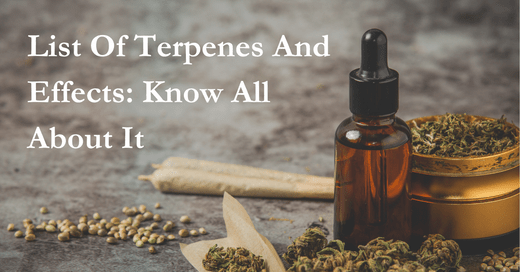
List Of Terpenes And Effects: Know All About It
Terpenes are aromatic compounds responsible for the scent and effects of plants, including cannabis. For example, pine promotes respiratory health and has anti-inflammatory effects. Limonene is uplifting and can elevate mood. Linalool provides calming, anti-anxiety effects. Caryophyllene offers anti-inflammatory potential while potentially easing stress. Myrcene promotes sedation and a feeling of relaxation. In this blog, you will learn about the list of terpenes and their effects in depth.
Table of Contents
Terpenes And Their Effects

Terpenes are organic chemicals released by plants, giving them their natural aromas. Each terpene interacts with a human being differently. Here are a few common terpenes:
- Pinene: Thorny in taste, this terpene is found in pine trees. It has anti-inflammatory properties and supports respiratory health by acting as a bronchodilator, improving airflow.
- Limonene: This terpene has a citrus aroma and is known to uplift mood and reduce stress. It exhibits antioxidant properties that could be used to reduce oxidative stress, which ultimately might cause skin damage and inflammation.
- Linalool: Linalool has a floral scent and is an acclamatory terpene responsible for inducing anxiety relief and sleeping. It also provides neuroprotection and anti-Alzheimer's effects by reducing symptoms.
- Caryophyllene: This terpene has a spicy and peppery smell. It is unique because of its interaction with the endocannabinoid system in the human body. It can help with inflammation, pain relief, and stress control.
- Myrcene: The earthy and musky scent it produces is attributed to myrcene. It usually causes full-body sedation and relaxation. Therefore, it's good for stress relief and a good night's sleep.
Each of them does something different in the way plants, especially cannabis, act upon both body and mind. Knowing their benefits will make you make more informed decisions on which terpene profiles suit your wellness needs.
Side Effects of Terpenes
Terpenes, while highly effective in addressing several human health issues, have a few side effects of their own, depending on the type and dosage in which one consumes them. Here are some side effects of terpenes:
- Irritation: High doses of certain terpenes, such as myrcene, result in irritations either to the skin or to the eyes. Similarly, undiluted terpene might harm your health, either inhaled directly into the lungs or taken internally.
- Somnolence: Myrcene, along with other terpenes, exerts sedative action that can make one lethargic and sleepy. This factor is more pronounced in cannabis strains with high myrcene content.
- Heightened Anxiety: There is a prospect that anxiety may be triggered in sensitive individuals due to specific terpene combinations; for example, the combination of beta-caryophyllene with highly dosed THC or limonene.
- Psychoactive Effects: While most terpenes themselves do not directly cause a high, they can enhance the action of THC and therefore create stronger psychoactive effects.
- Possible Cancer Risk: Some studies show that terpenes, such as myrcene, have anti-tumour properties, while other studies suggest they may be associated with cancer risk, although this is not firmly established.
It is always best to consult a medical professional before using terpenes, especially in large quantities.
Terpenes Chart and Effects
Terpenes are organic chemicals occurring in cannabis that give special aromas and flavours to the plant. Their function goes much deeper than just a smell, due to highly contributing to wellness benefits. Limonene, for example, is a chemical very frequently found in citrus fruits; it’s uplifting but often used to reduce stress and anxiety. Myrcene is an earthy, musky terpene responsible for the aroma of hops and thyme. It is attributed to sedative effects and is believed to enhance the body’s absorption of cannabinoids. Then, there’s linalool-one tied in lavender and touted for its ability to induce sedation, reduce anxiety, and even show pain-relieving properties. There is pinene, located in pine trees, providing a forest-like scent while helping mental clarity, perhaps providing a boost to lower inflammation. Last but not least, caryophyllene is a spicy terpene in black pepper that contains anti-inflammatory and pain-relieving properties, which is pretty neat to use naturally.
These terpenes interact in a “synergistic” way with cannabinoids like THC and CBD and can, therefore, apparently amplify the therapeutic effects of cannabis. Still under research, many people use terpene-rich products to deal with stress, enhance mood, and provide pain relief. Notwithstanding that, it is basic to consult a health professional before using terpenes or cannabis for health benefits.
Terpenes Side Effect

- Compounds are produced by most plants and many species of trees, especially in cannabis.
- It is responsible for aroma as well as flavour but also affects the human body.
Allergic Reactions:
- Users can face irritation on the skin or another respiratory problem .
- For most sensitive users, always test a small amount first to be safe. Mood Changes:
- Some terpenes, such as myrcene, will cause you to become drowsy, while others, for example, limonene, are more uplifting
The effects can differ so significantly for one person and another because each individual's biochemistry differs.
Gastrointestinal Problems:
- Some individuals may experience nausea or stomach disturbances when at higher dosages.
- Always start with a lower concentration.
Interactions with Medicines:
- Terpenes can interact with prescription drugs, changing their effects.
- If you are on medication, talk to a healthcare provider about plans to use before using
Headaches:
- Some individuals report headaches as potential associated effects from extremely strong odours or overusing
- If that happens to you, gradually reduce use, possibly.
Use Responsibly:
- Always educate and learn about the specific terpenes in your products.
- Start slow and be mindful of your body responding.
Terpenes can enhance the effects; however, knowing any potential side effects is important
Conclusion
Terpenes are aromatic in nature, contain many plants, especially cannabis, and all have different benefits. For example, mycene can facilitate relaxation, while limonene is a mood-booster. To make the best selection, one needs to understand their preferences, that is, whether they prefer being relaxed or paying attention. Start with small amounts, observing what your body reacts to, thus being able to see the complete scope of what terpenes offer. You get to safely indulge without going in blindly.
Frequently Asked Questions
Q. Which terpenes have which effects?
- Pinene: Thorny in taste, this terpene is found in pine trees. It has anti-inflammatory properties and supports respiratory health by acting as a bronchodilator, improving airflow.
- Limonene: This terpene has a citrus aroma and is known to uplift mood and reduce stress. It exhibits antioxidant properties that could be used to reduce oxidative stress, which ultimately might cause skin damage and inflammation.
- Linalool: Linalool has a floral scent and is an acclamatory terpene responsible for inducing anxiety relief and sleeping. It also provides neuroprotection and anti-Alzheimer's effects by reducing symptoms.
- Caryophyllene: This terpene has a spicy and peppery smell. It is unique because of its interaction with the endocannabinoid system in the human body. It can help with inflammation, pain relief, and stress control.
- Myrcene: The earthy and musky scent it produces is attributed to myrcene. It usually causes full-body sedation and relaxation. Therefore, it's good for stress relief and a good night's sleep.
Q. What terpenes get you the highest?
As for terpenes that can help increase psychoactivity, myrcene is usually at the top. Myrcene has sedative effects and facilitates THC absorption across the blood-brain barrier. In this way, it creates a higher, more intense high. Limoene increases mood and amplifies the euphoric effects of THC, making it very popular among users looking to get a buzzing effect from their herbal plant. Caryophyllene has a pungent, spicy fragrance. It is unique because it acts on the cannabinoid receptors; thus, its interaction may make the overall effects stronger. The choice depends on preference and effects, so experimentation using various strains will serve best in fulfilling your needs.
Q. Which terpene is best for laughter?
If you are looking for a terpene that might give you laughs and improve your mood, limonene fits the bill. This citrus-scented terpene is known to have uplifting effects. It has been associated with feelings of happiness and joy. Such an effect might be able to fight against stress and anxiety, calm the mind and body, and make you more open to laughter. Many users have reported to feel lifted in mood accompanied by a happy-go-light environment with these limonene-heavy strains, making it an amazing choice for a fun night in or social functions. So get set for some hilarious moments and start looking for some of these citrussy strains.
